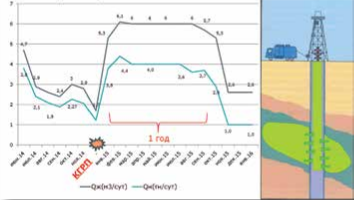- Home page /
- Technologies /
- Our publications about technologies /
- Application of Integrated “Acid – Proppant” Technology...
Application of Integrated “Acid – Proppant” Technology in Carbonate Reservoirs During Hydraulic Fracturing Operations
28.03.2018
M. Fadeev, Deputy Head, CTR, TagraS-RemService, LLC

Significant part of oil reserves of Volga-Urals region is located in the deposits represented by carbonate reservoirs. Such formations comprise of limestone and dolomites, mostly of massive composition, with various level of cavern porosity and fracturing. The majority of deposits is separated into blocks by tectonic abnormalities. Pressure communication of them with edge-water zones is constrained or absent at all. All the above seriously complicates development of such reserves.
The following items complicate effective hydraulic fracturing completion in carbonate deposits:
• Low formation pressures;
• Presence of near-by water-bearing horizons;
• Absence of rocks that can limit fracture height;
• Network of fractures that almost do not interconnect;
• Low efficiency of fracturing fluid.
In order to solve above-mentioned issues we
suggest hydraulic fracturing technologies that
will be listed further.
Acid fracturing with proppant fixation of fractures
Due to the presence of low formation pressures application of conventional acid fracturing may be not efficient.
This can be explained by partial closure (“collapse”) of fractures created and treated with acid.
High efficiency option of combining two types of hydraulic fracturing is provided by fixation of created fractures with proppant and deep penetration of acid into remote formation matrix, i.e. the shift of influence deeper into formation due to displacement profile (fracturing fluid with non-Newtonian properties is one of the most effecient materials for conformance control).
Combination of acid fracturing with proppant fixation of acid etched fractures by means of consecutive injection of acid and proppant packs is an effective technique of stimulation of low-permeability carbonate reservoirs with low formation pressures. It allows to organize profitable operation of wells for which other production stimulation methods turned inefficient.
.....
Full version of the article about this newest technology can be found in the recent issue of Coiled Tubing Times Journal.
-
24.12.2021
Gazprom Neft, Skoltech and the Khanty-Mansi autonomous okrug-Yugra are developing technologies to produce hard-to-recover oil
-
17.12.2021
Gazprom neft establishes Russia’s first test facilities for developing hard-to-recover oil production technologies
-
25.11.2021
LUKOIL successfully tries out casing drilling
-
08.11.2021
Gazprom Neft and Gazprom Burenie to support the development of Russia’s first oil- and gas-well drilling robot

